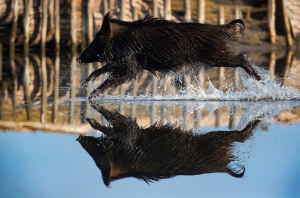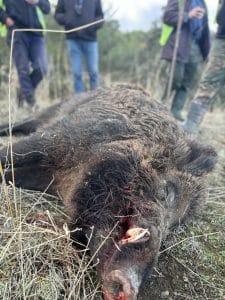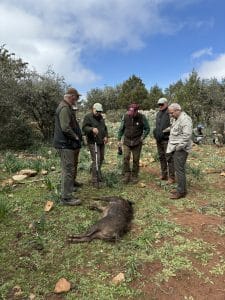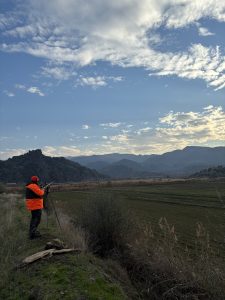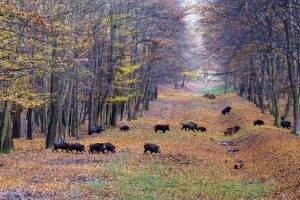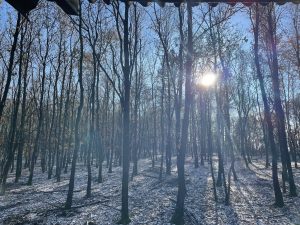Wild Boar Hunting Around The World
WILD BOAR / DRIVEN WILD BOAR / TROPHY WILD BOAR / WILD BOAR STALKINGYear Round Hunting, Exceptional Hospitality, Quality Trophies, Hunting For Meat
QUARRY
WILD BOAR
SHOOTING STYLE
DRIVEN | HIGH SEAT | SPOT AND STALK
LOCATION
VARIOUS
SEASON
ALL YEAR DEPENDING ON COUNTRY
Wild boar hunting is an exhilarating pursuit practiced around the globe, offering both adrenaline-pumping adventure and essential ecological benefits. In Europe, where hunting traditions run deep, methods like driven hunting are popular. This involves beaters driving the boars towards a line of hunters, creating intense, fast-paced action. Countries like Germany and France celebrate this as both a sport and a cultural heritage, balancing thrill with sustainability through regulated seasons and quotas.
In the United States, especially the wild terrains of the South, boar hunting takes on a rugged edge. Here, hunters often use spot and stalk techniques, tracking boars silently before making a precise, challenging shot. Night hunting with thermal scopes adds a modern twist, turning the hunt into a high-tech cat-and-mouse game.
Across Asia, such as in Japan and South Korea, hunting boars helps protect farmlands. Traditional spot and stalk methods are common, but hunters also employ innovative traps and dogs trained to flush out the elusive prey.
Down under in Australia, feral pigs are hunted vigorously to curb their destructive impact on the environment. Hunters often use a combination of off-road vehicles, dogs, and spotlights, turning the hunt into a high-speed chase across vast, rugged landscapes.
Whether through the strategic precision of spot and stalk or the communal excitement of driven hunts, wild boar hunting around the world is a dynamic blend of tradition, necessity, and thrilling sport.
From £350
Would you like to learn more?
WILD BOAR HUNTING DESTINATIONS
Wild Boar Hunting In England
Wild boar hunting in England has seen a resurgence in recent years due to the growing wild boar population in areas like the Forest of Dean and the Weald. Historically extinct in the country, wild boars have re-established themselves and now require management to prevent agricultural damage and ecological disruption. Hunting methods include spot and stalk and the use of high seats for ambush. Strict regulations ensure ethical practices, with hunters needing appropriate licenses and permissions. This resurgence has reintroduced an exciting and challenging pursuit for English hunters, blending modern techniques with traditional countryside management.
Driven Wild Boar In Hungary
Wild boar hunting in Hungary is a time-honored tradition, renowned for its exceptional game management and rich hunting grounds. The country’s vast forests and rolling hills, particularly in regions like the Bakony Mountains and the forests of Somogy County, offer ideal habitats for wild boar. Driven hunts, or “battue,” are especially popular, involving beaters driving boars towards strategically positioned hunters. Hungary’s well-regulated hunting practices ensure sustainable populations, making it a prime destination for both local and international hunters seeking thrilling and responsible hunting experiences amidst picturesque landscapes.
Driven Wild Boar In Morocco
Wild Boar Monteria In Spain
Year Round Hunting In Various Countries.
Exceptional Hospitality With Every Trip.
Experienced, Award Winning, Guides And Trip Organisers.
WILD BOAR – MORE INFORMATION
Blank
The Wild Boar
SCI Wild Boar Scoring
The Safari Club International (SCI) scoring system is a widely recognized method for measuring and recording the size and quality of game animals, including wild boars. The SCI scoring system is designed to provide an objective and standardized way to compare trophy sizes across different regions and species. For wild boars, the scoring focuses on the animal’s tusks, which are considered the most significant feature of the trophy.
Key Elements of SCI Scoring for Wild Boar:
Measuring the Tusks:
-
- The primary focus in SCI scoring for wild boars is the measurement of the animal’s tusks. Both upper and lower tusks are measured, but the upper tusks, known as “cutters,” are usually given more importance.
- Measurements are taken for both length and circumference. Each tusk is measured from the base to the tip, along the outer curve. The circumference is measured at the base of each tusk.
Total Score Calculation:- The total SCI score for a wild boar is the sum of the lengths and circumferences of both tusks. Specifically, it includes the length of each upper tusk and the circumference of each lower tusk.
- The scores from each tusk are combined to give the final score. This means a boar with long, thick tusks will score higher than one with shorter, thinner tusks.
Categorization:- Wild boar trophies are categorized into different classes based on their scores. These classes help hunters and conservationists to compare and record the quality of their trophies accurately.
Importance and Application:
-
Conservation Efforts:
- SCI scoring plays a crucial role in conservation efforts. By maintaining detailed records of wild boar trophies, scientists and wildlife managers can track population health and genetics, ensuring sustainable hunting practices.
-
Recognition and Awards:
- Hunters who achieve high SCI scores with their wild boar trophies are often recognized with awards and inclusion in SCI’s record books. This recognition serves as a benchmark of excellence in the hunting community.
-
Ethical Hunting:
- The SCI scoring system promotes ethical hunting by encouraging hunters to focus on mature, well-developed animals, which can contribute to better management and conservation of wild boar populations.
Overall, SCI scoring for wild boar provides a standardized, respected method for measuring and celebrating hunting achievements while promoting conservation and ethical hunting practices.
Where Can You Hunt Wild Boar?
Here’s a comprehensive list of locations around the world where you can hunt wild boar:
Europe
- Germany
- England
- France
- Spain
- Portugale
- Italy
- Hungary
- Poland
- Russia
- Austria
- Czech Republic
- Romania
- Bulgaria
- Croatia
- Slovakia
North America
- United States (notably Texas, Florida, Georgia, and Louisiana)
- Mexico
Asia
- Japan
- South Korea
- India
- Turkey
- Thailand
- Indonesia
Australia
1. Australia (notably Queensland, New South Wales, Northern Territory, Western Australia, South Australia, Victoria)
South America
- Argentina
- Uruguay
- Brazil
These regions provide a wide range of environments and hunting traditions, catering to various preferences and offering both challenges and exciting experiences for wild boar hunters.
Wild Boar Seasons
Seasons vary each year and from country to country so please get in touch for more details.
Would you like to learn more?
Wild Boar Hunting Around The World
Fincal La Caminera
Widiane Chasse
Frochas
Despenadero Alto
Chateau Matra
Las Loberuelas
